Plus my first Rough-legged Hawks of the season and a report on the drastic changes at Bear River MBR.
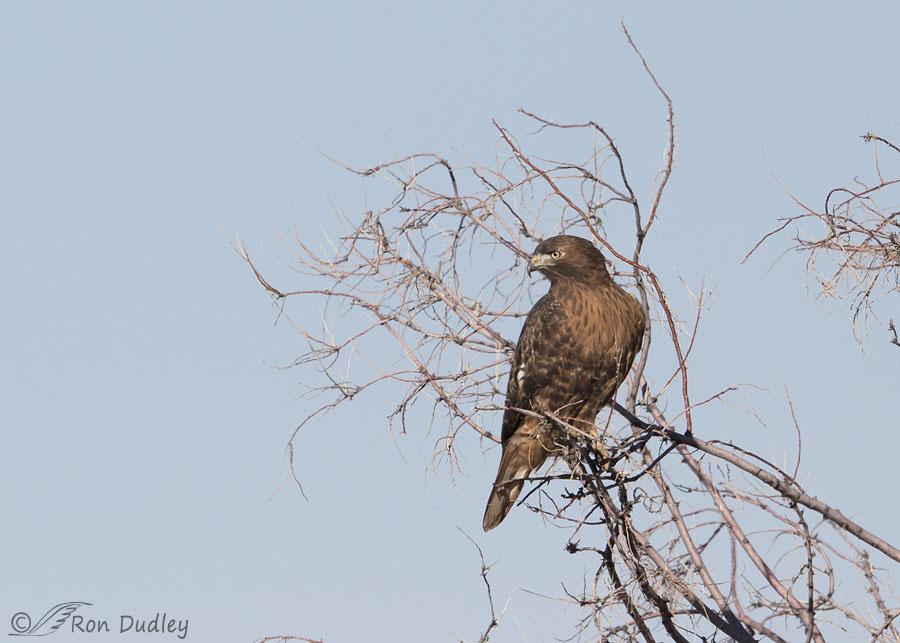
1/4000, f/7.1, ISO 400, Canon 7D Mark II, Canon EF 500mm f/4L IS II USM + EF 1.4 III Extender, not baited, set up or called in
This dark red color morph has become my favorite of all the variations of Red-tailed Hawks and that includes the Harlan’s. I don’t see these dark red birds very often and I think they’re striking and unusually handsome.
I photographed this one yesterday morning along the approach road to Bear River MBR. I wasn’t close enough for great detail while the bird was perched but I was hoping it would take off in my direction and eventually it did just that.
I always look forward to opportunities like this one because with all those twigs behind the bird it was unlikely to take off away from me so I could anticipate and prepare myself for it taking off generally in my direction.
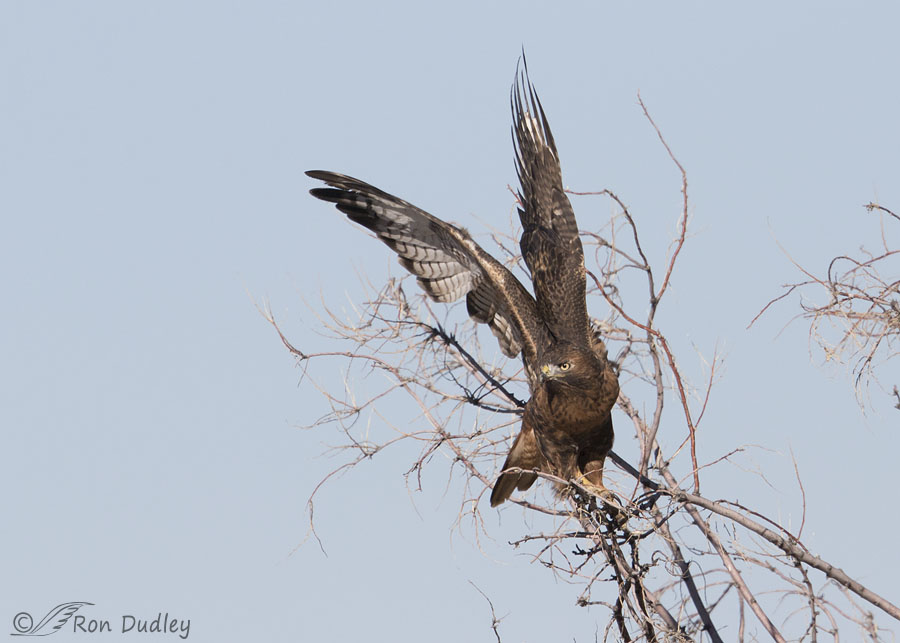
1/3200, f/7.1, ISO 400, Canon 7D Mark II, Canon EF 500mm f/4L IS II USM + EF 1.4 III Extender, not baited, set up or called in
The advantage to it not being particularly close was I had less chance to clip body parts when it took off. Too often I cut off the tips of the wings with this posture.
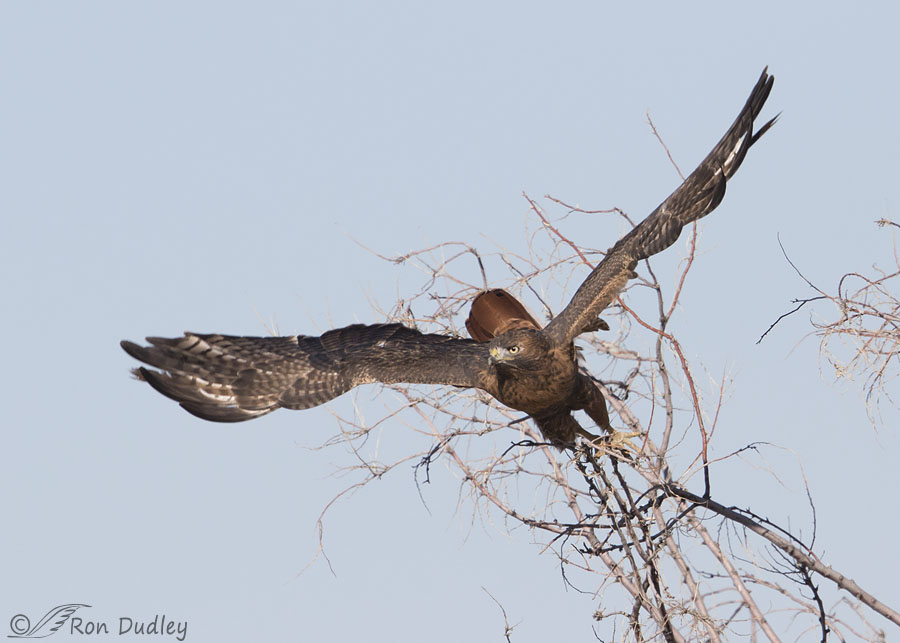
1/2500, f/7.1, ISO 400, Canon 7D Mark II, Canon EF 500mm f/4L IS II USM + EF 1.4 III Extender, not baited, set up or called in
I was lucky that the hawk kept its head turned to our left so we could see the eye throughout the entire series.
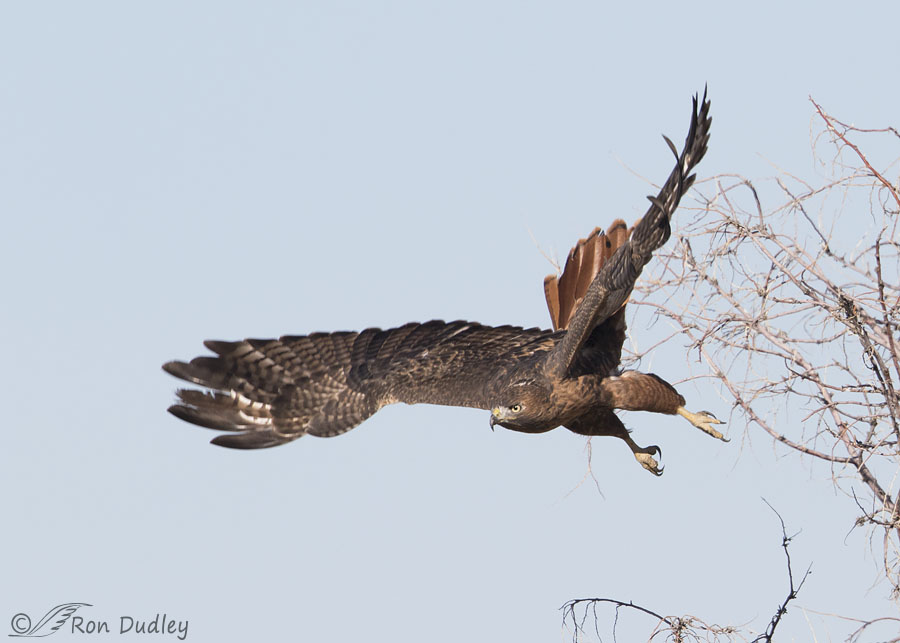
1/2000, f/7.1, ISO 400, Canon 7D Mark II, Canon EF 500mm f/4L IS II USM + EF 1.4 III Extender, not baited, set up or called in
This bird has the red tail dorsally of the adult but the light eye of the juvenile so it’s probably best called a sub-adult rather than a juvenile.
Bear River MBR was a study in contrasts yesterday – some of them positive and others not so much. For the first time all spring and summer the units near the auto-tour route have water in them. Lots of water, more water than I’ve ever seen in those locations! And they’ve burned so many phrags that many areas don’t look at all like they used to. The views are expansive because the tall phrags are gone but there’s sure a lot of habitat gone too. Thankfully the habitat will recover quickly in the spring and the invasive phrags should be greatlly reduced.
I’ve been visiting the refuge since the late 60’s and I don’t remember ever seeing fewer birds than I did yesterday morning. I imagine that’s at least partly a function of their phrag control efforts (burning and grazing cows) and it should only be temporary. But for now seeing so much water and so few birds at the refuge seems strongly counterintuitive to me. And depressing.
One of the very few highlights of my morning was seeing my first of season Rough-legged Hawks – three of them.
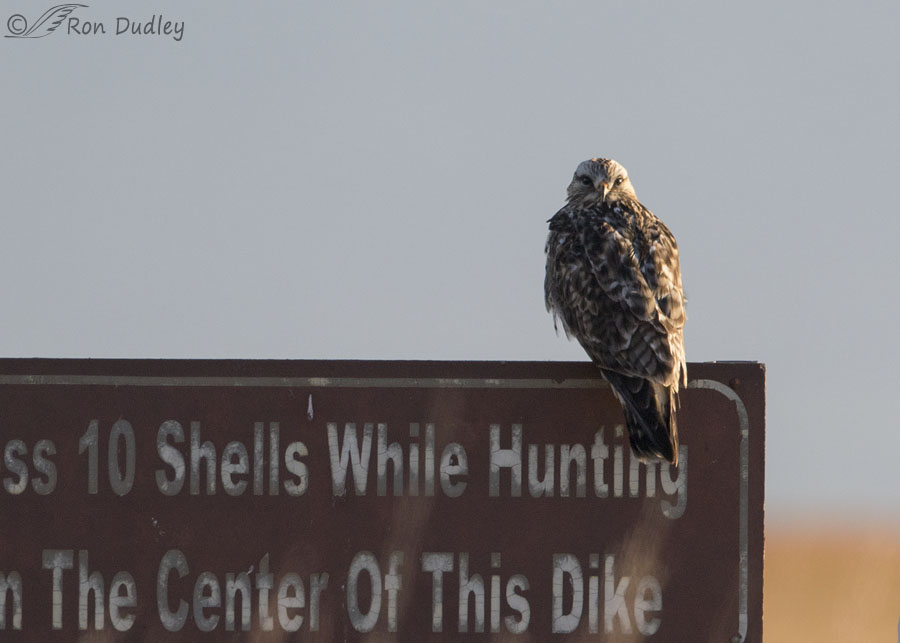
1/1600, f/6.3, ISO 800, Canon 7D Mark II, Canon EF 500mm f/4L IS II USM + EF 1.4 III Extender, not baited, set up or called in
The only photos I got were of this bird and they were worse than mediocre but they do document their presence on the refuge now, especially considering the sign it was perched on.
I can’t tell you how happy I was to see those three birds. Since the Swainson’s Hawks left for the winter our buteo populations have been greatly reduced and I always look forward to the return of the Roughies to help fill the void.
Our skies would seem empty and much diminished without soaring hawks.
Ron


A dynamic series of a beautiful bird!
Thank you, Ron! I really enjoyed reading your commentary.
Sue
Wonderful Red-tail images, Ron — especially that take-off shot. And though I think it’s hard to go wrong with RTs of any color/variety, this darkest morph IS stunning. Thanks for the Roughie, too, hoping you (and we) will get to see many more as the season wears on.
Nice study of takeoff behavior. Your images really accentuate the impressive wingspan of this hawk. I’ve been involved in marine bird surveys for a few years and all the long-time birders (as well as the other survey data) show a decrease in several species. Climate change, habitat destruction, pollution, disturbance by humans and their dogs, boats, cats, etc. The cards are stacked against birds and innumerable species.
“The cards are stacked against birds and innumerable species”
And sadly humans are playing with the same deck, Lyle.
Ron, your word gorgeous is very appropriate and then again. You must feel satisfied to get such great shots with the hawk cooperating on its take off.
My camera club is going to Antelope Island on 10/22. Never been there and kind of excited.
Thanks for the great photos and always great narrative. Glad you are getting out.
Thanks, Alice.
I hope you have a good time on the island. Birds have been pretty scarce out there for a while but there should be opportunities to photograph other subjects of interest.
Glorious colour. Glorious bird.
Hiss and spit at your continuing malady.
And sigh (with more than a hint of hiss and spit) at the diminished numbers of birds. We really are a species of slow learners.
We sure are, EC. Thank you.
What a beauty!!! So glad you were able to get these images…(hope your physical problems are resolved).
Thanks, Patty. I wish they were.
Excellent post Ron, and I have to agree with all those who use the word gorgeous for this hawk. I have never seen this Red-tail plumage, and agree it is very distinctive.
Interesting you should bring up the fewer birds seen comment. I wonder if others have that same observation. Many times I blame the lack of song birds around my yard, in bushes or at my feeders on the possibility of a predator in the area. But, I’m not convinced that that is the sole reason. When you keep records as I have, along with improving habitat, the data does prove that there are/seem to be less activity today than 5 years ago. Very concerning!
Hi Dick…just a quick note regarding your observation. I’m in NE Wisconsin near GreenBay. It seems to vary a little with species..I have 20 feeders in my yard and am always loaded with songbirds and other ‘feeder moochers’. there were very few ‘Rose Breasted Grosbeaks’ this year, no Pileated WoodPeckers, very few Red-Bellied and the number of Downy and Hairy seem down. I spend a lot of time in Michigan and did not see a single Red-Headed woodPecker this summer and not a Yellow-Bellied Sapsucker…this saddens me! I have seen quite a few Kestrals since migration so hopefully that will stay.
Hi Kathy,
Thanks. Yes, I believe it does vary by species. However, here in VT, at least where we live, our habitat has improved for various species over the past five years and relative to my records this year we had only two observations of Phoebe’s, 1 of an Eastern Pewee, no Great-crested Flycatchers. So far this year we have not had a single observation of a Warbler, although in the past, we have had by this time of year at least 3-4 species of Warbler. We still have Downy every day, Hairy 3-5 times a week, Goldfinches and an occasional House Finch. Comments from others in this community agree we have had fewer bugs/flying insects/dragonflies/damselflies. However, we did have a great year for Monarch butterflies. As well, the number of Tree Swallows were down. I have 12 boxes out, cleaned and ready in the spring and only 3 were occupied by Tree Swallows this spring/summer with 4 not occupied by any pair at all. Of those three only two boxes were successful. Normally, we have 5-6 occupied by Tree Swallows with at least 4 being successful. That is down by at least 50%. I just believe many are so close to this event they/we are blind to the coming extinction/rarity of many species. It’s a real downer!
I’ve heard many others say something similar, especially about our birds out west, Dick. Birds of a variety of species are simply becoming harder to find in the numbers we used to see them. Very sad.
I’ve only visited a few times over the last two years and don’t keep notes, but my overall feeling while there last week was ”where are the birds?” Again, I’m not a regular but my intuition has me wondering.
I was using those very words at Farmington this morning, Sandy.
That dark morph is much more attractive than the Red-tail’s normal coloring. Outstanding in-flight photos and the result of years of experience taking into consideration the branches behind the bird knowing that he or she would fly toward you. In my rush to get focused and be ready I often fail to consider things like how the bird is situated in its perch. Good reminder Ron – thanks.
Everett Sanborn, Prescott AZ
I sometimes forget to consider it too, Everett. But after almost 11 years of this bird photography thing it doesn’t happen very often anymore, as long as they give me enough time to think about it…
Wonderful series Ron!
Charlotte
Thanks, Charlotte.
What a gorgeous red-tailed hawk Ron! You must have been elated to have such a good experience watching it from afar. Your photos of it are awesome. I love the view of the top of its tail as it is taking off, and the eyes.
Probably very good news in the long run for Bear River NWR. I look forward to seeing it this winter.
I am intrigued by the RLHA’s . Tomorrow I will look for them in the San Luis Valley of Colorado. Normally they come much later in the winter. We are already getting pretty good snow though so perhaps they are already here. On warmer and drier years I have noticed a concentration of them on the Utah – Wyoming border area. Does this seem early in the year to see the RLHAs at Bear River NWR to you?
Thanks Ron
I hope you find some tomorrow, ED – might be a little early for you down there though.
Most years this is about the time I usually start seeing the first Roughies.
Man what a beauty this Red Tail is! Is it just me, or does its head seem quite large? Looks like this fine hawk has extra brain power working up there, truly a dominant appearance.
Not just you, Dave. Roughies have a distinctive head profile and this one was fluffed up a little from the cold (I’m pretty sure I could see frost on the bird).
Oh my! How I envy you right now! The Red Tail is beautiful. I too love those dark morphs…actually could you explain the ‘difference between a dark morph and a Harlan’s’? I don’t know where my mind ever got the idea of them being one and the same. We have a lot of Red Tails around here but not very many that are dark…in fact I only had experience with one. I couldn’t ID it so submitted photos to Hawk ID and I don’t think it was ever fully settled as either being a dark morph or Harlan’s…just debated because the photos themselves were dark being that they were taken on a dark gloomy winter day with the bird in a stand of spruce.
I too love those dark morphs…actually could you explain the ‘difference between a dark morph and a Harlan’s’? I don’t know where my mind ever got the idea of them being one and the same. We have a lot of Red Tails around here but not very many that are dark…in fact I only had experience with one. I couldn’t ID it so submitted photos to Hawk ID and I don’t think it was ever fully settled as either being a dark morph or Harlan’s…just debated because the photos themselves were dark being that they were taken on a dark gloomy winter day with the bird in a stand of spruce.
I have not spotted any RoughLegged yet…so your photo gives me encouragement. Oh what a beautiful face on that creature! And who cares if he is on a man-made sign…he is there. Anxious for more!
Kathy, actually a Harlan’s is one of the dark morphs of Red-tailed Hawks. I sometimes struggle with a confident ID of a Harlan’s too. Here’s a link that should be of interest to you:
http://fvaudubon.org/front-page/comparison-of-harlans-and-western-and-eastern-red-tailed-hawks/
That Red-tail is absolutely gorgeous! I’ve never seen one that dark before, and I think that the tail would be the only way I’d be able to tell what it was. Identifying Hawks is not a strong suit for me. I’m glad to hear that there is finally water back at Bear River MBR. Hopefully it will stay and there will be the usual breeding birds back there next spring. It’s also good that the Roughies are back. I’ll look forward to seeing some good portraits of them.
Susan, I also rarely see them that dark. Early this past summer there was a similarly colored nesting female in northern Utah that I photographed on two different occasions but I didn’t have good light on her so her colors didn’t look as good as they should have.
The main reason they have sufficient water at the refuge now is that the farmers have finished using most of the Bear River water for irrigation.
So that evidently means that the farmers have first priority for water during nesting season… Something wrong there.
Yes, and yes. Farmers and industry.
Could get lost in those! Whole new meaning to “tall grass prairie”!
Judy, usually they’re not as tall as 19′ but many of ours can be in the 10′-12′ range. The tallest ones grow in warm climates with fertile soils.
What a stunning bird! The dark brown/red coloring is magnificent!
The dark brown/red coloring is magnificent! 

 Did a little reading on Pragmites and see there are some native to MT tho in 2014 near Havre some invaders have been found. Have some “tall” reed type grass near the creek in places but not THAT tall! Makes me wonder about some of the tall ornamental grasses popular in landscaping now……. Always something showing up weed wise!
Did a little reading on Pragmites and see there are some native to MT tho in 2014 near Havre some invaders have been found. Have some “tall” reed type grass near the creek in places but not THAT tall! Makes me wonder about some of the tall ornamental grasses popular in landscaping now……. Always something showing up weed wise! 
Judy, yes there are some native phrags but most of them in our wetlands now are invasive. And extremely difficult to control. Some of them grow to over 19′ tall.
Hi Ron, very nice shots! How lucky you were for the Red Tail to take off toward you. I’m with you, there seems to be far fewer birds than in the past several years. And it seems to be like that in all the local locations I photograph. Not sure what’s going on.
Agreed, Gary. Bear River, Antelope Island and the causeway, Farmington, the west desert, northern Utah – they all seem to have significantly fewer birds than they used to. My biggest fear is that it’s largely because of climate change and that thought is not only depressing, it makes me very angry.